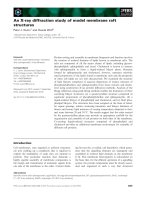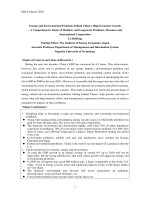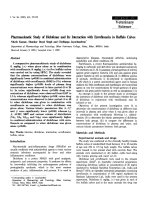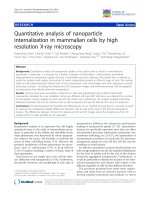High resolution x ray diffraction study of phase and domain structures and thermally induced phase transformations in PZN (4 5 9)%PT 1
Bạn đang xem bản rút gọn của tài liệu. Xem và tải ngay bản đầy đủ của tài liệu tại đây (6.32 MB, 76 trang )
HIGH-RESOLUTION X-RAY STUDY OF PHASE AND
DOMAIN STRUCTURES AND THERMALLY-INDUCED
PHASE TRANSFORMATIONS IN PZN-(4.5-9)%PT
CHANG WEI SEA
NATIONAL UNIVERSITY OF SINGAPORE
2009
HIGH-RESOLUTION X-RAY STUDY OF PHASE AND
DOMAIN STRUCTURES AND THERMALLY-INDUCED
PHASE TRANSFORMATIONS IN PZN-(4.5-9)%PT
CHANG WEI SEA
(B.Sc.(Hons.), UTM; M.Sc., NUS)
A THESIS SUBMITTED
FOR THE DEGREE OF DOCTOR OF PHILOSOPHY
DEPARTMENT OF MECHANICAL ENGINEERING
NATIONAL UNIVERSITY OF SINGAPORE
2009
i
Acknowledgements
I would like to express my heartfelt gratitude to my supervisor, Assoc. Prof
Lim Leong Chew for his constant encouragement and invaluable advice and guidance
throughout this research work.
My gratitude also goes to Prof. Tu Chih-Shun and his research group for
being supportive, caring, and helpful in numerous ways during my visit to Fu Jen
Catholic University, Taipei. I have also received a great deal of support and been
fortunate to work with Dr Yang Ping, Miao Hua, and Prof. Herbert O. Moser at
Singapore Synchrotron Light Source; Dr Ku Ching-Shun and Dr Lee Hsin-Yi at
National Synchrotron Radiation Research Center, Taiwan. Dr Yang Ping deserves a
special mentioning for ensuring smooth operation in diffraction experiments. Special
thanks to Prof. Amar S. Bhalla for his invaluable suggestion on the initial experiment.
My thanks and appreciation to technical staffs in Materials Science Lab,
namely, Thomas Tan, Ng Hon Wei, Abdul Kalim, and Maung Aye Thein; technical
staffs in Mechanical Engineering Fabrication Support Centre, namely Lam Kim Song,
Low Boo Kwan, and T. Rajah for their help in machining work. My appreciation also
goes to Microfine staffs Dr Jin Jing, Dr K K Rajan, Paul Lim, Lenson Lim, and Joy
Chuah for providing a good support in this work
Thanks to my friends for being there through good times and the bad and for
ii
all the great memories we have shared over these years.
Finally, I am especially indebted to my parents for their love and continuous
moral support. Without them, this work would never have been completed
This work was supported by Ministry of Education (Singapore) and National
University of Singapore, via research grants nos. R-265-000-221-112,
R-265-000-257-112, R-265-000-261-123/490 and R-265-000-257-731.
iii
Table of Contents
_________________________________________
Acknowledgements
Table of Contents
Summary
List of Figures
List of Tables
List of Symbols
Chapter 1 Introduction
Chapter 2 Literature Survey
2.1 Background
2.2 Ferroelectrics
2.2.1 Properties o Ferroelectrics
2.2.1.1 Piezoelectric Effect
2.2.1.2 Electro-optic Effect
2.2.2 Perovskite-oxide Type
2.3 Paradigms of Relaxor Ferroelectric Single Crystals Thus Far
2.3.1 Bulk Phase Transformation and Domain Studies
2.3.2 Surface Layer and Dual Phases
Chapter 3 Statement of Present Research
3.1 Objective of Present Work
iv
3.2 Scope of Present Work
3.3 Organization of Remaining Chapters
Chapter 4 Experimental Details
4.1 Sample Cut and Dimensions
4.2 Sample Preparation for Surface Layer Study
4.2.1 Mechanical Polishing
4.2.2 Fracturing Technique
4.3 Surface Layer Identification Methods
4.3.1 Normal X-ray Diffraction
4.3.2 High-resolution Synchrotron Radiation
4.3.3 Polarized Light Microscopy
4.4 Phase Transformation Studies
4.4.1 Polarization Characterization Methods
4.4.1.1 Dielectric Permittivity
4.4.1.2 Thermal Current Density
4.4.2 Structural Studies
4.4.2.1 High-resolution Synchrotron Radiation
4.4.2.2 Polarized Light Microscopy
Chapter 5 Surface Layer in Relaxor Ferroelectric PZN-PT Single
Crystals
5.1 Introduction
v
5.2 Polished Surface vs Fractured Surface at Room Temperature
5.2.1 Effect of Polished Surface on X-ray Diffraction Results
5.2.2 Effect of Polished Surface on Polarized Light Microscopy Results
5.3 Stability of the Polishing-induced Surface Layer
5.3.1 Thermal Stability
5.3.2 Electrical Resistance
5.4 Summary of Main Observations
Chapter 6 Tetragonal Micro/Nanotwins and Thermally-induced
Phase Transformations in Unpoled PZN-9%PT
6.1 Introduction
6.2 Theoretical Considerations of Diffractions from (002) planes of
Perovskite Crystals
6.2.1 Monoclinic Diffractions
6.2.2 Tetragonal Micro/Nanotwin Diffractions
6.2.3 Crystal Group Theory of Phase Transformation
6.3 Evidence of Tetragonal Micro/Nanotwins in PZN-9%PT at Room
Temperature
6.4 Thermally-induced Phase Transformations in Unpoled PZN-9%PT
6.4.1 Temperature Dependent Polarization Characteristics
6.4.2 Structural Studies
6.5 Summary of Main Observations
vi
Chapter 7 Rhombohedral Micro/Nanotwins and Thermally-induced
Phase Transformations in UnPoled PZN-4.5%PT
7.1 Introduction
7.2 Theoretical Considerations of Rhombohedral Micro/Nanotwin
Diffractions
7.3 Evidence of Rhombohedral Micro/Nanotwins in PZN-4.5%PT at
Room Temperature
7.4 Thermally-induced Phase Transformations in Unpoled PZN-
4.5%PT
7.4.1 Temperature Dependent Polarization Characteristics
7.4.2 Structural Studies
7.5 Summary of Main Observations
Chapter 8 Rhombohedral and Tetragonal Micro/Nanotwins Mixture
and Thermally-induced Phase Transformations in
Unpoled PZN-(6-8)%PT
8.1 Introduction
8.2 Room Temperature Phases of PZN-(7-8)%PT
8.3 Nature of Rhombohedral and Tetragonal Micro/Nanotwin Mixture
in PZN-(7-8)%PT at Room Temperature
8.4 Thermally-induced Phase Transformations in Unpoled PZN-8%PT
8.4.1 Temperature Dependent Polarization Characteristics
8.4.2 Structural Studies
vii
8.5 Thermally-induced Phase Transformations in Unpoled PZN-7%PT
8.5.1 Temperature Dependent Polarization Characteristics
8.5.2 Structural Studies
8.6 Summary of Main Observations
Chapter 9 Revised Phase Diagram for PZN-PT and Other
Observations
9.1 Revised Phase Diagram of PZN-PT System
9.2 Room Temperature Phase of PZN-PT Single Crystals of Different
PT Contents
9.3 Effect of Poling on Rhombohedral and Tetragonal Domains in
PZN- PT
9.4 Depolarization Phenomenon in Poled PZN-PT Single Crystals
9.5 Summary of Main Observations
Chapter 10 Conclusions
Chapter 11 Recommendations for Future Work
References
viii
Summary
Extensive (002)
pc
reciprocal space mappings have been performed on
annealed (unpoled) relaxor ferroelectric PZN-(4.5-9)%PT single crystals by means of
high-resolution synchrotron x-ray diffraction (HR-XRD). To avoid undesired surface
effects produced by mechanical polishing, a fracturing technique has been devised to
expose the relatively stress free crystal bulk for the HR-XRD study.
Evidence for rhombohedral and tetragonal micro/nanotwins could be detected
in the crystals. For PZN-(4.5)%PT, the room temperature rhombohedral phase exhibits
an extremely broad diffraction in most instances, being the convoluted peak of
{100}-type and {110}-type rhombohedral micro/nanotwin diffractions, while
respective micro/nanotwin diffractions could be resolved in a number of samples. The
increased growth and transformation stresses in PZN-(6-8)%PT promote the
coexistence of rhombohedral and tetragonal micro/nanotwins at room temperature in
these crystals. The tetragonal phase in this case is metastable stabilized by the residual
stress in the crystal, which partly transforms to the stable rhombohedral phase when
the residual stress in the surface layer is relieved by fracturing. This accounts for the
absence of (001)
T
diffraction in the exposed surface layer of the annealed crystals. At
room temperature, PZN-9%PT consists predominantly of {110}-type tetragonal
micro/nanotwins which behave in a coordinated manner upon heating. The fine details
ix
of the rhombohedral and tetragonal micro/nanotwin domains in PZN-PT single crystals
are deduced from the RSM results described above.
Based on the above finding and results of the heating experiments, a revised
phase diagram of the PZN-xPT system is constructed. An expanded morphotropic
phase boundary region is evident in the revised phase diagram, which spans from 0.06
≤ x ≤ 0.09 at room temperature. The ease of twinning via micro/nanotwin formation
and the existence of the broad (rhombohedral+tetragonal) two-phase field may explain
the high piezoelectric properties of relaxor-based piezoelectric single crystals of
compositions within the expanded morphotropic phase boundary region
x
List of Figures
Fig. 2.1 The interrelationship of symmetry elements and the subgroup ferroelectric.
Fig. 2.2 Schematic of ferroelectric hysteresis loop showing the spontaneous
polarization (P
i
), remnant polarization (P
r
), and coercive field (E
c
).
Fig. 2.3 (a) The cubic perovskite-type structure ABO
3
. (b) The off-centering
perovskite ABO
3
with ferroelectric behavior.
Fig. 2.4 The direction of the spontaneous polarization of non-centric of (a)
tetragonal, (b) orthorhombic, and (c) rhombohedral.
Fig. 2.5 Difference between normal and relaxor ferroelectric at
ferroelectric-to-paraelectric transition: (a) a sharp transition and (b) a
gradual, broad-diffuse and dispersive transition.
Fig. 2.6 The strain-E-field behavior of single crystals and ceramic ferroelectric.
Fig. 2.7 The first phase diagrams of (a) PZN-PT and (b) PMN-PT.
Fig. 2.8 Polarization rotation path in between the R-T phase transformation of high
piezoelectric relaxor-based ferroelectric single crystals.
Fig. 2.9 New phase diagrams of (a) PZN-PT and (b) PMN-PT.
Fig. 2.10 Schematic of T nanotwin superlattice. (101) twin planes are indicated by
dashed lines. A T unit cell is highlighted by gray shadow in respective twin
variants. The primitive superlattice translation vector is L. The volume
fractions of the first and second twin variants are ω and 1- ω, respectively.
The bilayer basis thickness is T.
Fig. 2.11 (a) High-resolution TEM image taken from a [001] PMN-0.35PT single
crystal; (b) power spectrum (fast Fourier transform) obtained from the
image; and (c) High-resolution TEM image taken from a [001]
PMN-0.35PT single crystal. The presence pf different domain regions in
the images designated as A, B, and C; the insets show power spectra (FFT)
obtained from (i) region A and (ii) region C.
xi
Fig. 2.12 (a) The inside and outer layer structures of PZN-PT single crystal system,
and (b) the revised PZN-PT phase diagram.
Fig. 4.1 (a) A schematic showing the two matching slots along the [100] direction of
the bulk single crystal. (b) A picture of the matching slots viewed under a
stereo microscope. The dotted line in (b) indicates the fractured plane.
Fig. 4.2 (a) Fractured plane of bulk single crystal for HR-XRD diffraction. (b) A
picture of the fractured plane viewed under a stereo microscope.
Fig. 4.3 The schematic of (a) beamline of high-resolution x-ray diffractometry in
SSLS and (b) differential movement of the rocking curve and detector to
produce a RSM.
Fig. 4.4 A picture of the ZFH ε’ measurement.
Fig. 4.5 A picture of the ZFH J measurement.
Fig. 4.6 (a) Temperature and (b) E-field dependent HR-XRD measurements.
Fig. 4.7 (a) Temperature dependent measurement for PLM studies. (b) The
interaction of plane-polarized light and the anisotropy crystal.
Fig. 4.8 The (001)-projection of the corresponding crystal polarization.
Fig. 5.1 (002) XRD profiles of PZN-4.5%PT single crystal taken from (a)
as-polished surface and (b) fractured surface.
Fig. 5.2 Same as Figure 5.1 but after the fractured surface of the PZN-4.5%PT
crystal sample was polished with SiC papers of different particle sizes. The
inset gives the intensity of the lower 2θ peak as a function of particle size
of the polishing medium.
Fig. 5.3 (a) (002) RSMs taken from the fractured surface of PZN-4.5%PT showing
only the main R (002) peak. (b) Same as (a) but taken from the as-polished
surface, showing the lower 2θ peak in the
ω
= 0° plane arising from the
spreading (or splitting) of the (002)
R
diffraction out of the
ω
= 0° plane but
toward lower 2θ values only. The intensity contours are on log scale.
xii
Fig. 5.4 (a), (c) and (e) (002) XRD profiles taken from the as-polished surface of
PZN-7%PT, PZN-8%PT and PZN-9%PT, respectively. (b), (d) and (f) same
as (a), (c) and (e) but taken from the fractured surface.
Fig. 5.5 (a), (c) and (e) (002) RSMs taken from the as-polished surface of
PZN-8%PT, PZN-9%PT and PZN-10.5%PT, respectively. (b), (d) and (f)
same as (a), (c) and (e) but taken from the fractured surface. The intensity
contours are on log scale.
Fig. 5.6 Same as Figure 5.4(b) but after the fractured surface of PZN-7%PT crystal
sample was polished with SiC papers of different particle sizes.
Fig. 5.7 Surface domain patterns of the (001)-cut PZN-4.5%PT crystal plate (a)
after polishing along the [010]
pc
direction and (b) after repolishing in the
[110]
pc
direction. Arrows indicate the direction of polishing. Note the
realignment from (a) to (b). (c) The domain patterns in the underlying
material revealed by the focusing technique.
Fig. 5.8 No clear surface domain patterns of (001)-cut PZN-4.5%PT crystal plate as
a result of none crystallographic polishing direction.
Fig. 5.9 (002) XRD profiles of as-polished (solid curve) and differently annealed
(dashed curves) PZN-4.5%PT showing the effects of the different
annealing treatments on the lower 2θ peak. Sample thickness is 1mm.
Fig. 5.10 (002) RSM taken from the as-polished surface of annealed PZN-4.5%PT,
showing the smeared contour lines over the area in the lower 2θ sides of
the main (002)
R
peak despite after annealing at 600 °C for 5 h. The
intensity contours are on log scale.
Fig. 5.11 (a), (c) and (e) (002) mappings taken from the as-polished surface of
PZN-7%PT, PZN-8%PT and PZN-9%PT after annealing at 257 °C for 1 h,
respectively. (b), (d) and (f) same as (a), (c) and (e) but taken from the
fractured surface. The intensity contours are on log scale.
Fig. 5.12 Effect of increasing poling field on the lower 2θ peak for as-polished
samples without any prior annealing. Note that the lower 2θ peak is largely
eliminated after poling to 1.5 kV/mm. Sample thickness is 1mm.
xiii
Fig. 5.13 Same as Figure 5.12 but for sample annealed at 600 °C for 1 h prior poling
treatment. Note the persistence of the lower 2θ peak after poling to 1.5
kV/mm at room condition. Sample thickness is 1mm.
Fig. 6.1 (a) M
A
, (b) M
B
, (c) M
C
, and (d) the relation between M
C
and O lattice.
Fig. 6.2 (002) diffraction intensity weighted distributions arising from (a) T
microdomains, (b) interference effect of T nanodomains and (c) combined
effect of (a) and (b). (d) to (g) show the projections of various T
diffractions onto the (002) RSM; i.e., diffractions arising from (d) untilted
T microdomains; (e) tilted T microdomains; (f) streaking effect of untilted
T nanodomains, (i) streaking effects of tilted T nanodomains, and (l)
combined diffraction patterns of T micro/nanodomains of all configuration.
Fig. 6.3 Lines between space groups indicate a group-subgroup relationship. Solid
lines indicate a first-order transformation. Dashed lines indicate a
second-order transformation.
Fig. 6.4 Temperature dependent (002) RSMs taken at (a) 25 ºC, (b) 70 ºC, (c) 125
ºC, (d) 170 ºC, and (e) 180 ºC. The {110}-type T twin planes are indicated
by white dashed line in (c). The intensity contours are on log scale.
Fig. 6.5 The diffraction planes are (a) parallel to the specimen with
ω
= 0º plane; (b)
inclined at angle ∆
ω
, and the corresponding RSMs for micro- and
nanoscale domains.
Fig. 6.6 Schematic illustration of coexistence of both untilted and tilted (100)
T
and
(001)
T
micro/nanodomains in PZN-9%PT single crystal. The tilted twins
give rise to the off
∆ω
= 0° diffractions with
∆ω
/2 ≅ 0.22º for the (100)
T
component and
∆ω
/2 ≅ 0.61º for the (001)
T
component, respectively. The
{110}-type T twin planes are indicated by red dashed lines.
Fig. 6.7 (a) ∆
ω
/2 and (b) Bragg’s position of (100)
T
and (001)
T
components of the
{110}-type T twins as a function of temperature. The T-C phase
transformation occurs at 180 ºC.
Fig. 6.8 (a) ZFH ε’ and (b) ZFH J of unpoled (annealed) PZN-9%PT crystal. The
sample thickness is 1.0 mm.
xiv
Fig. 6.9 Temperature dependent (002) RSMs taken from fractured surface of
annealed PZN-9%PT crystal obtained at (a) 25 ºC, (b) 55 ºC, (c) 70 ºC, (d)
100 ºC, (e) 125 ºC, (f) 140 ºC , (g) 160 ºC, (h) 170 ºC, and (i) 178 ºC. The
intensity contours are on log scale. The PZN-9%PT crystal consists of T
micro- and nanotwin domains and undergoes a sequence of
(R+T+T*)–(T+T*)–C phase transformation upon heating.
Fig. 6.10 ZFH domain structure of annealed PZN-9%PT crystal observed at by the
PLM (a) 25 ºC (P/A = 0º), (b) 25 ºC (P/A = 45º), (c) 55 ºC, (d) 65 ºC, (e)
125 ºC, (f) 145 ºC , (g) 170 ºC, and (h) 178 ºC. The sample thickness is
about 100
µ
m. The dominant T domains coexist with the small fraction of
R domains at 25 °C. The PLM observation is consistent with the HR-XRD
results.
Fig. 7.1 (a) Schematic domain configuration of an unpoled R crystal structure with
spontaneous polarization directed along eight <111>
pc
direction. (b) Three
dimensional illustration of a stereographic projection of the unpoled R
structure. In the two dimensional plane, only the four <111>
pc
variants are
projected.
Fig. 7.2 (a) Four of the eight <111>
pc
domain variants with tilt angle in both the
ω
and 2
θ
planes. (b) Each variant diffraction is represented by circles of
half-intensity contours. Individual variant diffractions broaden as a result
of residual stresses arising from the crystal growth process and
accompanied phase transformations during cooling of the crystal to room
conditions. The resultant RSM pattern is given in (b)-(d). In the actual
mapping, the detected diffractions are restricted to within the region of
dotted lines in (b). (d) The projection of the convoluted peak(s) on (002)
RSM.
Fig. 7.3 (a) The constructive interference effect of the two parent streaked of
{100}-type R nanotwin diffractions. (b) The resultant nanotwin diffractions
for {100}-type R nanotwins. (c) The projection of such extra peak joining
the two parent nanotwin diffractions on (002) RSM for the {100}-type R
nanotwins. Traces of the twin type are laid along the <100>
pc
direction.
Fig. 7.4 (a) The constructive interference effect of the two parent streaked of
{110}-type R nanotwin diffractions. (b) The resultant nanotwin diffractions
for {110}-type R nanotwins. (c) The projection of such extra peak joining
xv
the two parent nanotwin diffractions on (002) RSM for the {110}-type R
nanotwins. Traces of the respective twin type are laid along the <110>
pc
direction.
Fig. 7.5 (a) The projection of coexistence of the {100}-type and {110}-type R
nanotwins onto the (002) RSM. (b) The projection of the coexistence of R
micro- and nanotwins onto (002) RSM.
Fig. 7.6 Room temperature HR-XRD (002) RSM of unpoled (annealed)
PZN-4.5%PT single crystals. (a) shows a broad convoluted R peak while (b)
shows evidence of R micro- and nanotwins. These diffraction patterns
indicate the possible coexistence of {100}-type and {110}-type R* (see
text for details).
Fig. 7.7 (a) ZFH ε’ and (b) ZFH J of unpoled (annealed) PZN-4.5%PT crystal. The
sample thickness is 1.0 mm. A broad-diffuse and dispersive phase
transition in ε’ not only gives rise to a range of T
max
, but may mask the
weak anomalies in the ε’ curves.
Fig. 7.8 Temperature dependent (002) RSMs taken from fractured surface of
annealed PZN-4.5%PT crystal obtained at (a) 25 ºC, (b) 125 ºC, (c) 129 ºC,
(d) 135 ºC, (e) 145 ºC, (f) 146 ºC, (g) 148 ºC, (h) 155 ºC, and (i) 160ºC.
The intensity contours are on log scale. The PZN-4.5%PT undergoes a
transformation sequence of R*–(R*+T+T*)–T–(T+T*+C)–C upon heating.
Fig. 7.9 ZFH domain structures of annealed PZN-4.5%PT crystal observed by the
PLM at (a) 25 ºC, (b) 126 ºC, (c) 136 ºC, (d) 146 ºC, and (e) 154 ºC. The
sample thickness is about 50
µ
m. The PLM observation is consistent with
the HR-XRD results.
Fig. 8.1 Room temperature HR-XRD (002) RSMs of unpoled (annealed) (a) and (b)
PZN-7%PT, and (c) and (d) PZN-8%PT single crystals.
Fig. 8.2 Temperature dependent (002) RSMs taken from fractured surface of
annealed PZN-8%PT crystal obtained at (a) 25 ºC, (b) 80 ºC, and (c) 95 ºC.
The intensity contours are on log scale.
Fig. 8.3 Temperature dependent (002) RSMs taken from fractured surface of
another annealed PZN-8%PT crystal of predominantly R phase to begin
xvi
with at room temperature: (a) 25 ºC, and (b) 90 ºC. The intensity contours
are on log scale.
Fig.8.4 Volume expansion associated with T-R transformation in PZN-PT single
crystals. Note that the abrupt increase in volume associated with the
transformation when x > 0.07.
Fig. 8.5 Domain configurations of coexistence R* and T* domain structures. The
arrows represent the directions of the polar axis in T phase. The two polar
directions are joined by the {110}-type T* as indicated by the red solid
lines. The {110}
R
//{110}
T
interface are indicated the by blue solid lines.
Note that the T
σ
phase is metastable in this case, stabilized by the residual
stress in the crystal
Fig. 8.6 Geometry of the {110}
R
//{110}
T
interface (in blue) and domain
arrangement in the mixture of R and T
σ
phases. The {110}
R
//{110}
T
interface is either (a) perpendicular to or (b) lying at 45° to the (001)
diffracting plane.
Fig. 8.7 Schematic illustrations of the two-phase coexistence, R and T
σ
after
fracturing. (a) For {110}
R
//{110}
T
interface perpendicular to the (001)
diffracting plane, the effect of stress relaxation produced by fracture is not
as significant. Thus, the T
σ
phase remains metastable and both R and (100)
T
can be detected from the fractured surface. (b) For slant {110}
R
//{110}
T
interface, the constraints produced by the neighbouring R phase in the
crystal is removed by fracturing, causing the T
σ
phase to transformed to the
R phase in the surface layer. Thus, only R diffraction can be detected from
the fractured surface. For x-ray of low energy as in the present work, the
diffraction profile thus depends on the penetration depth in the (see text for
details).
Fig. 8.8 Room temperature HR-XRD (002) RSM of an as-grown (unpoled)
PZN-6%PT. Peaks d
3
, d
4
and d
5
are R* diffractions, while peaks d
1
and d
2
are the (100)
T
diffraction and (001)
T
microtwin diffractions, respectively
(see text for details).
Fig. 8.9 (a) ZFH ε’ and (b) ZFH J of unpoled (annealed) PZN-8%PT crystal. The
sample thickness is 1.5 mm
xvii
Fig. 8.10 Temperature dependent (002) RSMs taken from fractured surface of
annealed PZN-8%PT crystal obtained at (a) 25 ºC, (b) 80 ºC, (c) 95 ºC, (d)
120 ºC, (e) 140 ºC, (f) 150 ºC , (g) 160 ºC, (h) 165 ºC, and (i) 173 ºC. The
intensity contours are on log scale. The PZN-8%PT undergoes a
transformation of (R*+T
σ
)–(R*+T
σ
+T)–T–(T+T*+C) –C upon heating.
Fig. 8.11 ZFH domain structures of annealed PZN-8%PT crystal observed by the
PLM at (a) 25 ºC, (b) 85 ºC, (c) 105 ºC, (d) 145 ºC, (e) 165 ºC, and (f) 168
ºC. The sample thickness is about 100
µ
m. The PLM observation is
consistent with the HR-XRD results.
Fig. 8.12 (a) ZFH ε’ and (b) ZFH J of unpoled (annealed) PZN-7%PT single crystal.
The sample thickness is 1.0 mm.
Fig. 8.13 Temperature dependent (002) RSMs taken from fractured surface of
annealed PZN-7%PT crystal obtained at (a) 25 ºC, (b) 95 ºC, (c) 100 ºC, (d)
105 ºC, (e) 115 ºC , (f) 140 ºC, (g) 155 ºC, (h) 160 ºC, and (i) 168 ºC. The
intensity contours are on log scale. The PZN-7%PT undergoes an
(R*+T
σ
)–(R*+T
σ
+T)–(T+T*)–(T+T*+C)–C phase transformation sequence
upon heating.
Fig. 8.14 ZFH domain structures of annealed PZN-7%PT crystal observed by the
PLM at (a) 25 ºC, (b) 100 ºC, (c) 110 ºC, (d) 125 ºC, (e) 145 ºC, and (f) 165
ºC. The sample thickness is about 100
µ
m. The PLM observation is thus
consistent with the HR-XRD results.
Fig. 9.1 The revised phase diagram of PZN-PT system with extended (R+T) MPB
region. The extended (R+T) MPB region can be divided into two regions.
In the lower PT region, 6% ≤ x ≤ 8%, the T phase is metastable, denoted by
T
σ
.
The T
σ
is stabilized by the residual stresses in the crystal. In the high PT
region, 9% ≤ x ≤ 10.5%, both the R and T are thermodynamically stable at
room temperature. A two-phase (T+C) coexistence region was detected at
high temperature before the crystal transforms to a single C phase.
Fig. 9.2 HR-XRD diffraction patterns of unpoled (a) PZN-4.5%PT, (b) PZN-7%PT,
and (c) PZN-8%PT at room temperature. The a
R
and
α
R
of the respected
crystals are given in Table 9.1
Fig. 9.3 Room temperature (002) RSMs of annealed-and-optimally-poled (a)
xviii
PZN-4.5%PT and (b) PZN-7%PT single crystals. The poling field is normal
to the (001)
pc
diffraction plane. The intensity contours are on log scale. (c)
and (d) show the RSMs of their unpoled counterparts for comparison
purposes.
Fig. 9.4 E-field dependent (002) RSMs taken at (a) 0 kV/mm, (b) 0.5 kV/mm, and
(c) 0.8 kV/mm from the fractured surface of [001]-poled PZN-9%PT. The
E-field dependent RSM reveals an (R+T)–T transformation under an
E-field application along [001]
pc
direction. The intensity contours are on log
scale.
Fig. 9.5 PP-ZFH J of the [001]-annealed-and-poled (a) PZN-4.5%PT and (b)
PZN-7%PT single crystals.
Fig. 9.6 PP-ZFH ε’ curves of the [001]-annealed-and-poled PZN-4.5%PT and
PZN-7%PT single crystals from which the “T
R-T
” was determined from the
first anomaly.
Fig. 9.7 Temperature dependent (002) RSMs taken from fractured surfaces of the
[001]-annealed-and-poled PZN-4.5%PT single crystal: (a) 100 ºC, (b) 125
ºC, and (c) 135 ºC. The intensity contours are in log scale. T
#
indicates the
vague T diffractions. T
NT
denotes the T at ∆ω ≠ 0º.
Fig. 9.8 Temperature dependent (002) RSMs taken from fractured surfaces of the
[001]-annealed-and-poled PZN-7%PT single crystal: (a) 105 ºC, (b) 110 ºC,
and (c) 115 ºC. The intensity contours are in log scale. T
#
indicates the
vague T diffractions. T
NT
denotes the T at ∆ω ≠ 0º.
Fig. 9.9 Dielectric hysteresis behaviors of [001]-poled PZN-4.5%PT recorded
during the heating-cooling cycles to (a) 100 ºC, (b) 105 ºC, (c) 115 ºC, and
(d) 125 ºC, respectively. After heating to 105 ºC, PZN-4.5%PT showed
clear signs of hysteresis on cooling to room temperature. Above this
temperature, the area of the dielectric hysteresis increases with increasing
heating temperature. The heating and cooling rate is 1.5 ºC/min.
Fig. 9.10 (a) K
T
and (b) k
31
of four plate samples of [001]-poled PZN-4.5%PT taken
at room temperature after cooling from the temperatures indicated on the
x-axis. Both the K
T
and k
31
of PZN-4.5%PT started to degrade after it was
heated to 105 ºC.
xix
List of Tables
Table 2.1 Work performed thus far on phases and domain studies of PZN-PT.
Table 4.1 The optical and crystallographic properties pf the seven crystal systems.
Table 4.2 Optical extinction angles of various phases along (001)-projection.
Table 6.1 Relationship between the m and pc axes for various M phases and the O
phase in the unpoled state.
Table 9.1 Deduced lattice parameters for the R phase at room conditions.
Table 9.2 T
DP
, T
R-T
(L)
and T
R-T
(U) of [001]-poled PZN-PT single crystals
xx
List of Symbols
R : Rhombohedral
T : Tetragonal
M : Monoclinic
M
A
: Monoclinic A
M
B
: Monoclinic B
M
C
: Monoclinic C
O : Orthorhombic
C : Cubic
R* : Rhombohedral micro/nanotwin
T* : Tetragonal micro/nanotwin
T
σ
. :
Tetragonal at metastable state which stabilized by residual stresses
ZFH : Zero-field-heating
PP-ZFH : Prior-poling zero-field-heating
E : Electric field
SiC : Silicon carbide
XRD : x-ray diffraction
HR-XRD : High-resolution synchrotron x-ray diffraction
RSM : Reciprocal space mapping
PLM : Polarized light microscope
xxi
FWHM : Full-width-at-half-maximum
ε’ : The real part of the dielectric permittivity
J : Thermal current density
dP/dt : Change in polarization per unit time
θ : Bragg’s angle
ω : Omega plane
pc : Pseudocubic axes
m : Monoclinic axes
β : Monoclinic angle
a
R
: Lattice constant
α
R
: Rhombohedral angle
f : Frequency
T
C
: Curie temperature
T
max
: Temperature at which the ε’ is at its maximum
T
DP
: The depolarization temperature which perceptible degradation of
dielectric and electromechanical properties begins
T
R-T
: The rhombohedral-to-tetragonal transformation temperature
T
R-T
(L) : Temperature at which rhombohedral-to-tetragonal transformation
begins
T
R-T
(U) : Temperature at which rhombohedral-to-tetragonal transformation
completes
xxii
k
31
: Electromechanical coupling constant
K
T
: Dielectric constant
MPB : Morphotropic phase boundary
SSLS : Singapore Synchrotron Light Source
TEM : Transmission electron microscope
1
Chapter 1
Introduction
Touted as next-generation materials for future high-performance transducers,
sensors, and actuators, relaxor-based ferroelectric single crystals of
Pb(Zn
1/3
Nb
2/3
)O
3
–PbTiO
3
(PZN-PT) and Pb(Mg
1/3
Nb
2/3
)O
3
–PbTiO
3
(PMN-PT)
solid-solutions display superior piezoelectric and electromechanical properties (i.e.,
with d
33
> 2500 pC/N, k
33
> 90%, maximum strain > 1.7%) [1] compared with
state-of-the-art Pb(Zr
1-x
Ti
x
)O
3
(PZT or lead zirconate titanate). The astonishing
performance has driven intense research on physical properties of these materials to
aid the development of ferroelectric devices.
Over the past decade, three theoretical considerations have been postulated in
explaining the superior properties of PZN-PT single crystals. In the first, the superior
properties have been attributed to the result of polarization rotation, suggesting that the
presence of lower symmetry phases, i.e., monoclinic (M) phases act as the structural
bridge between the rhombohedral (R) and tetragonal (T) phase transformation. In the
second, the superior properties are explained by the soft elastic constants of R structure
which inherently infers a large piezoelectric distortion, resulting in a strained or
distorted R phase (instead of the M phases). In the third, the adaptive ferroelectric









